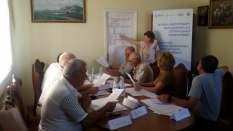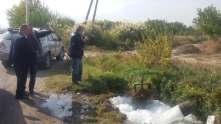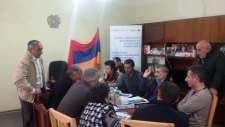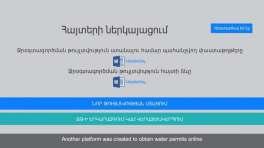
9 minute read
RESULT AREA 4: SMALL-SCALE WATER INFRASTRUCTURE PILOTS IDENTIFIED AND IMPLEMENTED
4.1․ Identify and submit to ASPIRED at least five pilot projects, leading to increased and sustained community water access designated and developed by capacitated community-based organizations and residents (including women and youth)
Pre-project situation: The baseline survey identified that in almost all communities of Ararat Valley the water stress was also caused due to obsolete, dilapidated and damaged drinking and irrigation water infrastructure. More than 60% of the households of Ararat Valley did not have regular drinking water-supply: it was either a scheduled supply or supply with unscheduled interruptions. Over 45% were dissatisfied with the quality of drinking water. Many respondents mentioned that they do not consider/use water received in their house tap as “drinking water” and they get drinking water from other places or buy it. Regarding the irrigation water supply, the water users in Ararat Valley mentioned that they were getting irrigation water predominantly either from the community irrigation canals or artesian boreholes. Half of the water users have agricultural land plots, apart from their backyard plot. Around 45% do not receive regular irrigation water to irrigate agricultural land pots. Among frequently brought reasons were lack of irrigation water supply system or decrease of the amount of water resources in artesian boreholes.
Advertisement
Achievements
Increased and sustained drinking and irrigation water access is in place designed and developed with direct input of water users
5 improved water infrastructures are in place: 2 drinking water infrastructure 3 irrigation water infrastructure
Aratashen Community, Armavir Region: improved drinking water infrastructure
Yeghegnut Community, Armavir Region: improved drinking water infrastructure
Vedi Community, Ararat Region: improved irrigation infrastructure
Pokr Vedi Community, Ararat Region: improved irrigation infrastructure
Khachpar Community, Ararat Region: improved irrigation infrastructure
19,000 people benefit with improved irrigation system 5,000 people have uninterrupted drinking water supply
The PURE Water planned to improve drinking and/or irrigation water systems and supply in 5 target communities. All 12 target communities of the project had the aforementioned problems. Under this component, the PURE Water closely cooperated with another USAID-funded project for Ararat Valley, ASPIRED project. With support of the PURE Water the target communities reveal their problems regarding drinking water and irrigation, put together and submitted the proposals to the PURE Water for small-scale. The proposals were reviewed by PURE Water and ASPIRED. After the review, ASPIRED provided engineering design and ensured implementation of construction activities. The PURE Water ensured public/environmental monitoring during the construction activities.
Participatory approach was also at the core of identifying and implementing small-scale water infrastructure projects (SSWIP). Below are the steps of participatory development of infrastructure projects with support of the PURE Water:
Town-hall meetings were convened in target communities The residents of the communities identified problems regarding drinking and irrigation water infrastructure 7-10 co-citizens were selected by participants of the town-hall meeting to form Community working groups (CWG). There were supposed to represent the community residents at all stages: design, implementation and monitoring of infrastructure projects CWGs prioritized water sector problems identified during the town-hall meeting by the residents using Delphi methodology.
CWG works on prioritization of water problems


Town-hall in Vedi


CWGs received a special training by the project to apply Delphi methodology. It is based on weighting and scoring approach coming up with a total score considering of the weighted scores of each evaluation criteria: cost, positive environmental impact, beneficiary coverage, and public support. CWG prioritizes water problems A professional committee was created (members: the project engineer, the mayor, municipality water specialists, GWG representative) to make onsite observations to figure out how the prioritized ideas were realistic, make corresponding professional adjustments and report back to the CWG for their final approval. Special trainings for target municipalities on project design and management, proposal writing. Mentoring and on site coaching was provided during the proposal writing process.
Site visits by specialized Committee




Committee reports to CWP on findings
Submission of the project proposals by target communities (Annexes RA 4-10 - RA 4-14). Review of the proposals by the PURE Water and ASPIRED projects: engineers and USAID representatives also participated in the review process as consultants and observers without the right to vote. 5 projects were approved based on criteria and scoring system required by RFA. Below are main selection criteria: - Relevance to the prioritized needs - Feasibility - Replicability and sustainability - Innovative elements - Community contribution, etc.
Technical/engineering concepts and cost estimations of the selected projects were prepared by ASPIRED. ASPIRED also announced a tender for design and construction activities and modified the implementation of the construction works. The PURE Water developed the environmental monitoring and mitigation plans for each infrastructure project in compliance with the USAID environmental requirements (Annexes RA 4-1 - RA 4-5). Environmental training was conducted with the community residents and active group members for monitoring construction activities and for providing basic knowledge about the rights and responsibilities of residents during the construction activities. 5 infrastructure projects have been completed with total 24,000 beneficiaries: 2 projects in drinking water sector (Aratashen, Yghegnut, Armavir region) with 5,000 beneficiaries and 24-hour water supply and 3 in irrigation water sector (Vedi, Pokr Vedi, Kachpar, Ararat region) with 19,000 beneficiaries.
Infrastructure projects in brief:
3,000 RESEIDENTS OF ARATASHEN, ARMAVIR REGIONS HAVE 24HOUR DRINKING WATER SUPPLY
For decades, Aratashen‟s old and inefficient water system caused excessive water loss and posed high contamination risks for the locals. With no capital investment in the system since the Soviet era, nearly 80% of the water leaked out through corroded pipes. Lack of water metering system, in its turn, resulted in unreasonably high waste of water. Mayor Vahram Harutyunyan admits they would operate three pumps, yet round-the-clock water supply remained unattainable for the village. Some parts of Aratashen, particularly its remote areas, didn‟t get any water during the summer season when the water demand was especially high.
In response, USAID‟s Advanced Science and Partnerships for Integrated Resource Development (ASPIRED) and Participatory Utilization and Resource Efficiency of Water (PURE Water) projects, together with the community of Aratashen, joined their efforts to rehabilitate Aratashen‟s water supply network. Assistance included installation of 10 km of corrosion-resistant polyethylene piping, new pump, chlorination station, and water metering devices, as well as introduction of new billing software for water supply services. These vital improvements will now allow the community to save 557,000 cubic meters of water and 204 megawatt-hour of energy each year.

Improvement of drinking water supply in Araratshen and Yeghegnut community, Armavir region: Assistance included design of drinking water systems and installation of corrosion-resistant polyethylene pipes, a new pump (Aratashen), chlorination stations, and water metering devices. Individual water meters were installed for each household. The municipality signed contacts with the future drinking water users. Improvements ensured uninterrupted drinking water supply in both communities, as well as water and energy savings which has been evidenced by the residents as a result of follow-up household survey (Annexes RA 4-7 - RA 49). The survey instrument was installed and the municipal staff trained to use it due to the PURE Water project. The official water analysis in both communities showed that after the construction activities the quality Opening ceremony: Aratashen has uninterrupted drinking of drinking water met required standards (Annexes RA water supply 4-16 – RA 4-17). 5,000 residents benefited in two Aratashen’s water supply challenges are common for more than communities. 30 communities in the Ararat Valley, currently experiencing critical shortages of drinking and irrigation water due to the Municipal Irrigation Project in Vedi, Ararat region: The depleting groundwater resources in the valley. project provides a new irrigation system for the municipal park and the soccer field for the town of Vedi. The existing irrigation system is fully renovated to reduce water loss, groundwater saving and ensure more efficient and affordable irrigation for the Municipality (Annexes RA 4-6).
Irrigation Improvement Project in Pokr Vedi Community, Ararat region: The project has been successfully completed during the reporting period. The Project is implemented jointly by the USAID (ASPIRED and PURE Water Projects), Hayastan All-Armenian Fund (AAF) and Artashat Water User Association. The existing corroded pipes were replaced with more durable plastic pipes. Plastic pipes also were installed instead of existing earth ditches; existing pipes have been replaced or repaired to ensure operational efficiency. As a result of the project the irrigation efficiency for 160 hectares of land was improved, including 40 hectares of arid community farmlands was returned to cultivation. The project enables income generation opportunities for 400 land-owners who will directly benefit from improved irrigation network.

Improving Efficiency of Irrigation in Khachpar Community, Ararat region: The project improved the availability of irrigation water for

Khachpar village. As a result the Hayastan All-Armenian Fund joins PURE Water and ASPIRED to improve P. Vedi irrigation community will receive about 250 l/s of water which will meet its irrigation water needs. The earth canal was replaced with a plastic pipeline. Inlet and outlet chambers and related infrastructure were built. This will help to prevent the solid waste particles from getting into the water stream and to manage the water flow: The project also repaired existing roadside canals inside the village and increased their flow capacity to 250 l/second. The results of water quality testing in Khachpar community were satisfactory meeting the accepted standards.
Challenges and Recommendations Challenges
Poor capacity in project design and development. Poor participation culture: some target communities were more interested in infrastructure projects then introducing the culture of participation in their communities. They participated more when they anticipated receiving an award to improve community infrastructure. Once they did not receive award, they became less cooperative. Political situation in Yeghegnut with the mayor‟s dismissal and in Pokr Vedi with tensions between the Mayor and Council members required additional risk-mitigation efforts and delayed the project implementation. Limited amount of SSWIP did not allow award more target communities which were committed and cooperative. COVID-19: delayed construction activities.
Recommendations
Combine capacity building, behavior change-driven activities with material support: provision infrastructure and/or equipment. Such an approach will keep the partner communities committed in the course of implementation of the project. In the meantime, the activities aimed at capacity building and behavior change should be carried out continuously. Over time, it will become a habit and gradually, a culture. Still many communities in Ararat Valley remain water-stressed. The Government needs to continue to support water-stressed communities to improve their water infrastructure.





